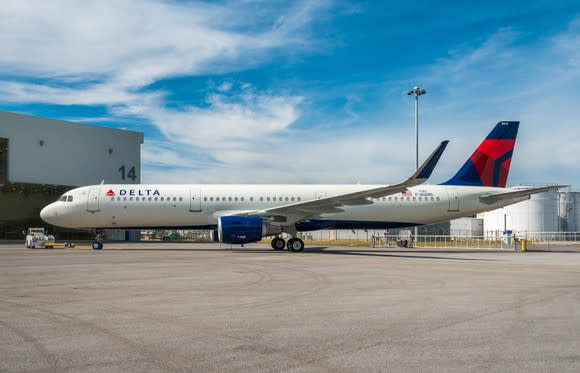Delta Air Lines, Inc. Q4 Earnings: Revenue Momentum Returns
Beginning in late 2014, jet fuel prices plunged, delivering a huge windfall for Delta Air Lines (NYSE: DAL) and its peers. However, this development sparked an uptick in pricing battles within the airline industry. Eventually, the resulting unit revenue declines -- along with rising nonfuel costs -- ate away most of the industry's fuel cost savings.
Fuel prices are back on the rise, making it essential for airlines like Delta to deliver consistent unit revenue growth in 2018. Fortunately, Delta's fourth-quarter results and Q1 2018 outlook indicate that it is finally regaining its revenue momentum.

Delta Air Lines is seeing strong demand across the world. Image source: Delta Air Lines.
Delta earnings by the numbers
In the fourth quarter, Delta Air Lines' unit revenue growth accelerated sharply, with airline revenue per available seat mile (RASM) up 4.4% year over year. This compared to a 2.7% increase in airline RASM in Q3 and a 1.7% gain for the first nine months of 2017 as a whole. As a result, revenue rose 8.3% to $10.25 billion last quarter.
This uptick in RASM growth allowed Delta to post a solid profit despite facing significant cost headwinds. The following table highlights some of Delta Air Lines' key earnings metrics for the fourth quarter.
Metric | Q4 2017 | Year-over-Year Change |
|---|---|---|
Revenue | $10.25 billion | 8.3% |
Adjusted pre-tax income | $1.03 billion | 11.1% |
Adjusted pre-tax margin | 10% | Up 0.2 points |
Adjusted EPS | $0.96 | 17.1% |
Total airline unit revenue | 16.65 cents | 4.4% |
Adjusted nonfuel unit costs | 11.2 cents | 5.6% |
Data source: Delta Air Lines Q4 earnings releases. EPS = earnings per share.
According to the official results, Delta's pre-tax margin of 10% was up slightly year over year. Combined with strong revenue growth and share buybacks, that caused adjusted pre-tax income to rise by 11% and adjusted EPS to surge 17% compared to Q4 2016.
However, Delta signed a new pilot contract during the fourth quarter of 2016, and spent $380 million on retroactive pay in December 2016. This represented a 4-percentage-point pre-tax margin headwind for that quarter.
Excluding this one-time expense, Delta's year-over-year comparisons look a lot less impressive. Adjusted nonfuel unit costs would be up 5.6% (compared to a 0.4% decrease otherwise), while Delta's pre-tax income, pre-tax margin, and adjusted EPS would all be down significantly year over year.
Strong revenue across the world
Delta Air Lines' ongoing margin pressure (on a fully comparable basis) indicates the importance of maintaining strong RASM growth throughout 2018. One promising sign in that regard is that Delta finally has unit revenue moving in the right direction in every region of the world.
The transpacific market -- which has been a weak spot for five years -- remained the biggest laggard last quarter, but Delta still posted 1.6% unit revenue growth there. Meanwhile, unit revenue rose 3.5% in its domestic network, 7.4% on transatlantic routes, and 4% in Latin America. This balanced performance is more likely to be sustainable than unit revenue growth driven by just one or two regions.
The pressure is on
Looking ahead to the first quarter, Delta Air Lines expects unit revenue growth roughly in line with its fourth-quarter results, with passenger RASM up 2.5%-4.5%. Still, that won't come close to fully offsetting Delta's cost increases. Nonfuel unit costs are set to rise 2%-4% in the quarter, while Delta expects to pay $2.05-$2.10/gallon for fuel, compared to $1.71/gallon a year earlier.
On the bright side, Delta will reap quite a bit of savings from corporate tax reform. The company projects that its book tax rate will fall to roughly 22%-24% this year, from around 35% recently. As a result, Delta's quarterly EPS guidance of $0.60-$0.80 is roughly in line with its Q1 2017 adjusted EPS of $0.77.
On a full-year basis, Delta Air Lines has significantly more ambitious goals. Nonfuel unit cost growth is expected to decrease sharply after the first quarter (due to the timing of expenses and an ongoing cost-cutting program). That should help Delta stabilize its pre-tax margin.
As a result, Delta now expects to post full-year 2018 EPS of $6.35-$6.70, including the benefit of tax reform, up from $4.93 in 2017. If the company manages to achieve this lofty target, Delta Air Lines stock could zoom higher in 2018.
More From The Motley Fool
Adam Levine-Weinberg owns shares of Delta Air Lines. The Motley Fool has no position in any of the stocks mentioned. The Motley Fool has a disclosure policy.

 Yahoo Finance
Yahoo Finance 